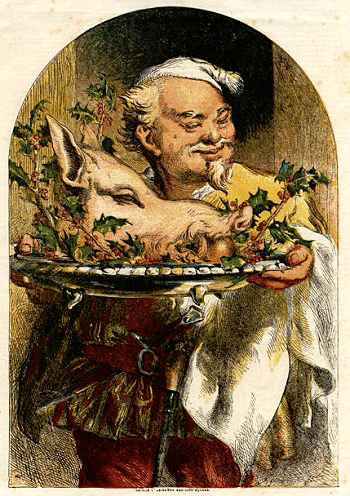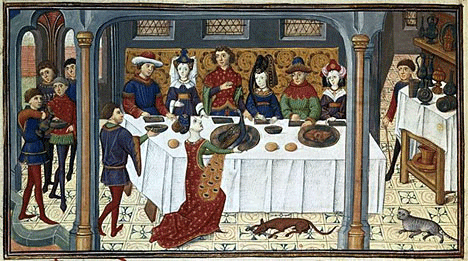he evolution of Christmas dinner is a story of robust, merry feasting reaching down through history. Just where and when the first Christmas feast occurred isn’t known. But by the 11th century, strange and marvelous dishes loaded long tables in holly decked banquet halls during 12 days of bountiful yuletide feasting.
Great hunting expeditions sallied forth to fetch the yuletide bird and a wild boar, for a boar’s head was a special treat in medieval times. Even the autocratic peacock graced the tables of England’s feudal lords. Skinned before roasting, stuffed with spices and sweet herbs, and then reclothed in its own feathers, it was finally brought to the banqueting hall, not by a servant, but in stately pageant headed up by the mistress of the house. To the strains of music and attended by her retinue of lovely young maidens, the lady carried in the bird. Around it flocked young knights-errant to make their solemn vows over its feathers and pledge their swords to the romantic adventure of rescuing fair maidens in distress.
But the bird was rather dry—even the far-from-finicky cooks of the time admitted that—but served in all its gorgeous plumage, with its bill gilded to a glittering gold, and with lots of gravy, it was at least something to feast the eyes upon.
Preceding the proud peacock was the ceremony of bringing in the boar’s head, a custom dating as far back as 1170. Two handsomely dressed heralds raised silver trumpets to their lips as the chief cook carried in a massive silver platter containing the boar’s head, garnished with a substantial wreath of bay, sprigs of rosemary in its ears and a roasted apple in its mouth. Minstrels and other servants carrying in lesser dishes to grace the “groaning board,” as the table was said to “groan” from the weight of all the food, followed this lordly entré.
Not only in England, but in many lands, pork played a special role in the Christmas menu. Though historians argue over its significance, some believe it was a symbolic renunciation of heathenism. A medieval interpretation of the 80th Psalm said: “Where Satan is the Wild Boar out of the wood.” To carry in the head of the boar in triumph was a testimony to Satan’s defeat.
At the dawn of the 16th century, swans became a common Christmas delicacy. On Christmas Day, 1512, in the Duke of Northumberland’s household, the cook prepared five swans for dinner. Fifty years later the menu contained not only a roast swan, but a goose and even a “turkie”—all boiled, not roasted, and served with celery sauce.
Roast beef of Old England, whether boiled or roasted, was a savory reminder of the Druids’ sacrificing of the bulls when the sacred mistletoe was cut. Vegetables included roots such as beets, carrots, colwrots, parsnips, salsafy, skirrets, and turnips. Potatoes appeared in 1586 but were a rarity until after the Restoration.
One indispensable old-time English Christmas dish which has been long forgotten was furmety, or frumenty. According to an old recipe, it consisted of “Wheat boiled till the grains burst, and when cool strained and coiled again with broth or milk and yolks of eggs.” Eventually, cooks added dried plums (prunes), raisins, a slice of ginger cake, currants, and an egg or two to create plum pudding. Originally intended to suggest the richness of the Wise Men’s gifts, it has come to symbolize Christmas in England.
Medieval cooks first made mince meat pies in an oval shape to represent the cradle and in their original form, they were more meat than sweet. In 1394, one enterprising cook took pheasant, rabbit, capon, two partridges, two pigeons, and two conies and chopped them up, baked them in a crust shaped like a bird with a head at one end and a great tail at the other.
As for drink, Christmas revelers drank wassail, a traditional drink made of a mixture of hot ale, sugar and nutmeg, from “good brown bowls.” On Christmas Eve, people roasted apples on a string until they dropped off into a great bowl of this hot ale, making the beverage into “Lamb’s wool.”
Even here in America, people bring down punch bowls from the shelf. As the cups go around, the mirth and wassail echo back to the joviality of those long departed days.
Merry Christmas



